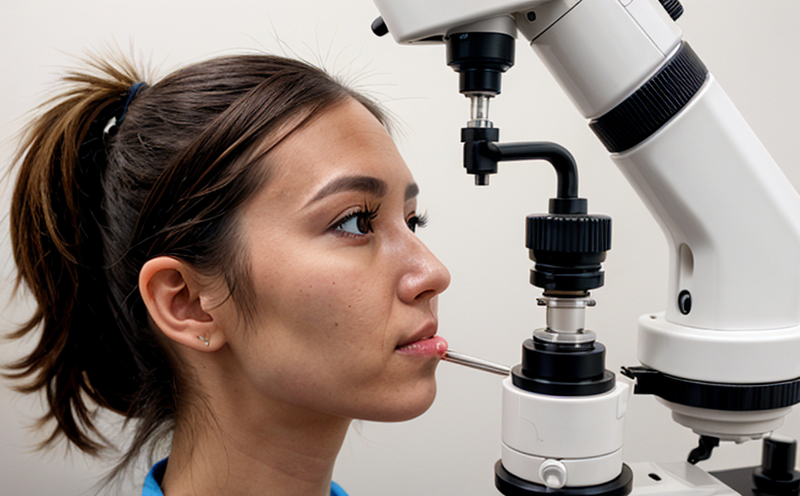ISO 8596 Visual Acuity Chart Testing for Ophthalmic Devices
The ISO 8596 standard is a pivotal tool in the evaluation of visual acuity charts used within ophthalmic devices. This test ensures that the visual acuity chart's design and calibration meet the stringent requirements laid out by international standards, which are critical for accurate measurement and interpretation of visual performance.
The process involves rigorous testing to ensure that the visual acuity chart can be accurately read at various distances and angles, ensuring that any ophthalmic device utilizing such a chart provides consistent and reliable results. The test is not only important for product quality but also for patient safety, as incorrect readings could lead to misdiagnosis or inappropriate treatment.
The ISO 8596 standard focuses on several key aspects of visual acuity charts:
- Calibration accuracy
- Resolution and contrast
- Uniformity of the chart pattern
- Distance and angle requirements for optimal reading
The testing process involves placing the ophthalmic device in a controlled environment that simulates real-world conditions. The visual acuity chart is then presented to the device, and its output is compared against known standards. This ensures that the device can accurately interpret the chart under various lighting conditions and from different viewing angles.
The calibration of the visual acuity chart is crucial as it directly affects the accuracy of the ophthalmic device's readings. A poorly calibrated chart could lead to significant discrepancies in the results, which could have serious implications for patient care. The testing process involves meticulous measurement and comparison with established standards to ensure that any deviation from these benchmarks is minimized.
The resolution and contrast of the visual acuity chart are also critical factors. High-resolution charts provide more detailed information, while adequate contrast ensures that the chart can be clearly read even under challenging lighting conditions. This is particularly important in ophthalmic devices where precision is paramount. The testing process involves evaluating these aspects to ensure they meet the required standards.
The uniformity of the chart pattern is another key aspect of ISO 8596 compliance. A non-uniform chart can lead to inconsistent readings, which could affect the accuracy and reliability of the ophthalmic device. The testing process involves checking for any variations in the chart's pattern to ensure that it meets the required standards.
The distance and angle requirements are also critical for ensuring accurate visual acuity measurements. The testing process involves placing the visual acuity chart at various distances and angles to simulate real-world conditions. This ensures that the ophthalmic device can accurately interpret the chart under a wide range of conditions, providing consistent and reliable results.
Compliance with ISO 8596 is essential for manufacturers of ophthalmic devices as it ensures that their products meet the highest standards of quality and reliability. This not only enhances product reputation but also ensures patient safety by minimizing the risk of misdiagnosis or inappropriate treatment. The testing process involves rigorous evaluation to ensure that the visual acuity chart meets all the required standards.
The ISO 8596 standard is widely recognized in the medical device industry, and compliance with this standard is essential for manufacturers who want to ensure their products meet the highest quality standards. It also ensures that ophthalmic devices can be accurately calibrated and used consistently across different environments and conditions.
Applied Standards
| Standard | Description |
|---|---|
| ISO 8596:1994 | Visual Acuity Charts for Ophthalmic Devices - Requirements and Test Methods |
| EN ISO 8596:2003 | Visual Acuity Charts for Ophthalmic Devices - Requirements and Test Methods |
| ASTM F1746-18 | Standard Practice for Calibration of Visual Acuity Charts Used with Refractive Instruments |
Customer Impact and Satisfaction
- Ensures consistent and reliable results from ophthalmic devices
- Reduces the risk of misdiagnosis or inappropriate treatment
- Enhances product reputation among healthcare providers and patients
- Facilitates compliance with international standards, ensuring regulatory approval
- Improves patient safety by minimizing errors in visual acuity measurement
- Simplifies quality control processes for manufacturers
- Aids in the training of medical professionals to use ophthalmic devices accurately
- Supports continuous improvement in product design and functionality
International Acceptance and Recognition
The ISO 8596 standard is widely recognized and accepted across the globe, making it an essential tool for manufacturers of ophthalmic devices. Compliance with this standard ensures that products meet the highest quality standards and can be used consistently across different environments and conditions.
Many countries have adopted ISO 8596 as a mandatory requirement for the calibration and testing of visual acuity charts in ophthalmic devices. This ensures that manufacturers can market their products globally without facing regulatory challenges or delays.
The standard is also recognized by regulatory bodies worldwide, making it easier for manufacturers to obtain approvals from these bodies. Compliance with ISO 8596 is a key factor in ensuring that ophthalmic devices meet the required standards and can be used safely and effectively.





